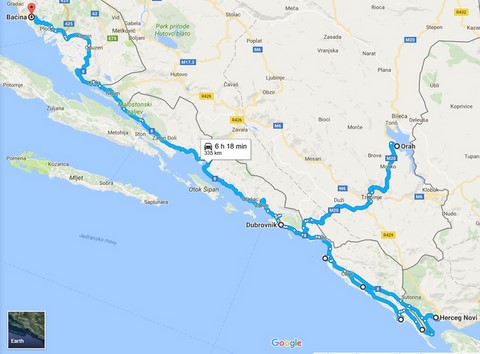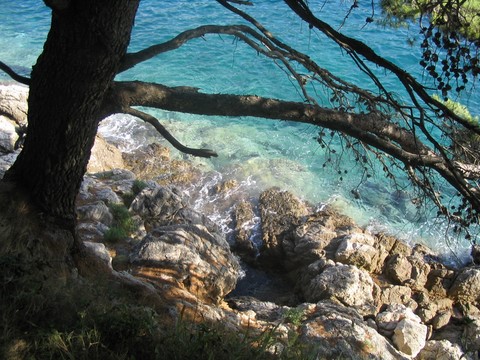Croatia
You can click on the map and on pictures to enlarge them
In 2007, we decided to go to Croatia. Indeed, I had already been there in 1979 when it was still part of Yugoslavia. All of nine years-old, I kept an unforgettable memory of my three weeks journey on Rab Island. So I wanted to go back there with J.R., choosing the South of the country that time, notably Dubrovnik.
During that trip, we took a ride to Montenegro, and we must admit that the checkpoint on the border cast a chill: a man in uniform armed with an assault rifle searched the vehicle after keeping our passports for a long time. Arrived at Herceg Novi, we had to face a few hostile glances, for our car rental was registered in Croatia. Then, we had to face the facts: the scars of the war were still present. That is what we also realized with horror when we went for another ride to Bosnia, particularly devastated. It is all the more regrettable that former Yugoslavia is full of remarkable landscapes and villages.
As for the Croatian coast, it is composed of deserted coves, countless islands bathed in turquoise and transparent water, and typical villages with cobbled pedestrian streets. The significant amount of cypress is explained by the subsistence of a local tradition: after every marriage, the man plants twenty-four of them in order to bring the couple fertility.
On the other hand, you can only find shingle beaches. Some of them have large plates of concrete fitted out above the rocks with swimming pool ladders to have access to the water. What locals call «sandy beaches» are actually stretches of much smaller pebble, close to gravel, such as e.g. in Dubrovnik.
Finally, we returned to that nice country in 2010 from Slovenia for a few hours ride to the Istria region.
Dubrovnik, «the Pearl of the Adriatic», former Ragusa, is a medieval fortified city with a Historic Center bounded by imposing ramparts. It blossoms with charming climbing cobblestone streets, churches and cloisters. It opens to the rest of the city by sumptuous gates. Terraces are constantly animated by a young and light atmosphere. The visit of the ramparts offers a stunning view of the Adriatic. The small port is located in a beautiful cove bathed in ocher rocks.
The famous Libertas Summer Festival takes place in July and August in an amazing Baroque and Renaissance setting. Literary works are in the spotlight, as well as dance, ballet and music, as much medieval as contemporary. The opening ceremony firework above the harbor is breathtaking.
Lapad is a superb bay near Dubrovnik, from where you can admire the sunset in a sweet summer atmosphere. The Adriatic Sea is smooth as a mirror. At the end of day, the last swimmers enjoy the peace and the space which is offered to them, which is inconceivable in broad daylight. Croatian children skim stones in laughter and joyful cries. The part of the bay which is nearest to the long pedestrian walkway lined with bars, restaurants and shops has a beach where pebbles are much smaller.
Zaton is a typical fishing village located a few kilometers north of Dubrovnik. Its pretty bay is surrounded by high mountains of the Dalmatian hinterland. Many villas adorn the seaside.
Cavtat (photo) is a charming medieval harbor city. The setting is very nice and very quiet. Its microclimate allows the presence of subtropical plants. It has many monuments in Renaissance with traces of Gothic inspiration: palace, fortifications, churches and convents.
Molunat is a fishing village located in the southern end of the Croatian coast. We discovered it unexpectedly as we had lost our way. Indeed, you often come across extraordinary and little visited places when you get lost.
Traces of the past are present, as archaeological sites in the sea bed and onshore, ramparts and fortresses. The very indented coastline has many coves and peninsulas and two islets covered with a thick scrub, holm oaks, cypress and pinewoods. The clear waters abound in fish. Nature is much preserved.
The Baćina Lakes are a set of six freshwater lakes linked together in the heart of a valley. They are located close to the village of the same name, near the harbor city of Ploče. You can see them below from the road and the parking. Refreshing green and turquoise colors mix in pleasant and varied greenery, from which the traditional cypress stand out. Some of them are adorned with small pontoons and huts on the shore, which adds to their charm. It is a peaceful, idyllic and not much visited place. You can join it since Dubrovnik by a road that runs along the coastline, offering a breathtaking view on the Adriatic coast. It crosses a few kilometers long part of Bosnian territory. But the border crossing is a mere formality: nothing to do with the checkpoint between Croatia and Montenegro mentioned in the introduction.
Motovun is a very nice fortified stone village perched on a hill more than 200 meters high. Motorized access is not permitted, which makes the visit all the more pleasant. The view of the Istria Valley is breathtaking. Ramparts from the medieval period, the Saint-Stephen Church, a crenelated tower provided with a bell and a sumptuous palace make it an unforgettable place.
Opatija is located on the shore of the Kvarner Gulf. Filled with the charm of Neo-Classical seaside resorts, it did manage to protect itself from intensive concreting to remain attractive and keep the nostalgia from an Austrian-Hungarian bygone period. Pastel colored stylish villas in the heart of lush and exotic gardens run along. There, you have a feeling of well-being and get the impression of being back to the 19th century during a very short trip.
Published on December 1st 2012





